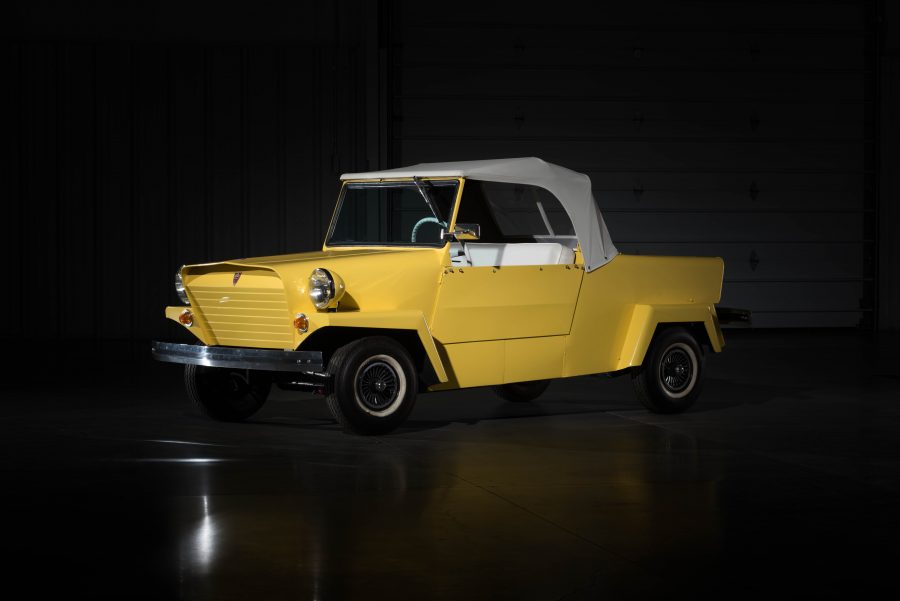This fully restored King Midget Model 3 features a non-standard Briggs & Stratton V-twin engine with an automatic transmission. From the Tammy Allen Collection.
SCM Analysis
Detailing
| Vehicle: | 1962 King Midget Model 3 |
| Years Produced: | 1957–70 (Model 3) |
| Number Produced: | Approximately 5,000 (all models) |
| Original List Price: | $950 |
| SCM Valuation: | Median to date, $6,875; high sale, $14,850 |
| Tune Up Cost: | $10 |
| Chassis Number Location: | Top of frame under left rear fender |
| Engine Number Location: | Varies |
| Club Info: | The International King Midget Car Club |
| Website: | www.kingmidgetcarclub.org |
| Alternatives: | 1946–52 Crosley, 1952–2002 Cushman Truckster, 1959–61 Crofton Bug |
| Investment Grade: | D |
But can it mow the lawn?
Every once in a while in the automotive life, you’ll encounter something like a King Midget. These tiny cars were part of a recurring craze in the automotive world: the idea that you can build an incredibly cheap, incredibly economical, teensy-weensy little car and people will buy it.
The number of companies that have attempted this formula is almost beyond count, because most of them made very few cars and faded into obscurity with nothing but a second mortgage on the entrepreneur’s house and an unhappy wife to show for the effort. Brands like the Auto Cub, Autoette, Brogan, Citicar, Colt, Crofton, Electra-King, Eshelman, Imp, Nu-Klea, Publix, Pup, Saviano, Scootmobile, and a dozen others that you’ve never heard of all came and went very quickly.
Long lived the King
In the midst of all those ambitious but ill-fated attempts, the King Midget stands more or less alone in its longevity and success.
The Midget Motors Corporation was founded in 1946 and first produced an open-wheeled kit car that looked very much like a Midget Sprint racer. It was powered by a 6-hp garden engine, or any engine you cared to install, and at first offered a 3-speed manual transmission with no reverse gear. In the beginning, it was offered only in DIY-kit form, advertised as “the world’s lowest-priced car” at just $270.
As production ramped up, the King Midget was offered with a single-speed automatic, but again with no reverse gear.
In 1951, the King Midget Model 2 was released. This one could fit two people and came with a 7.5-hp engine. The Model 2 was more like a real car both in looks and in functionality, although you still probably wouldn’t want to drive one on public roads.
The price of a Model 2 was $550 in the mid-1950s. At that price, the King Midget was competing against normal-size cars that could drive at highway speeds, such as the Kaiser Henry J at about $1,400. Not surprisingly, King Midget sales were mainly made to technology and DIY enthusiasts.
The King Midget Model 3 was introduced in 1957, and it was as close as the King Midget was ever going to get to a real driving alternative for your average buyer. This one was over a foot longer than the Model 2, had hydraulic brakes on all four wheels, a 2-speed automatic transmission, and depending on the year you bought, you got either a 9- or 12-horsepower engine. The King Midget Model 3 was produced virtually unchanged from 1957 to 1969, along with some other experimental models, scooters, and dune-buggy-type creations.
The original owners of the Midget Motors Corporation sold the business in 1966, and the company went bankrupt by 1969. The spare parts and assets were sold and passed among various individuals, and now the enthusiastic brand club is the custodian of the King Midget legacy. The brand’s 24-year operating run is respectable, as is the continued interest in these vehicles.
God save the King
Today, the King Midget still looks like a kit car you’d buy through an ad in Popular Mechanics. There’s nary a compound curve to be found anywhere, and it looks like the whole car was made by a couple of Boy Scouts using a sheet-metal brake.
But the frame is a welded unibody that works well for its purpose, and to be honest, the King Midget wasn’t too far off what brands like Fiat and Citroën were selling in Europe. The result is that a King Midget makes an interesting and affordable addition to any collection. And if you don’t mind being the smallest thing on the road, driving one is fun.
Our subject Midget is about as nicely restored as you’re likely to find anywhere. The seller has replaced the original single-cylinder engine with a modern V-twin Briggs & Stratton engine at around 18–23 horsepower, mated to the original 2-speed automatic transmission. The rest of the engine bay, including fuel tank, has been reconfigured to accommodate the new engine. That’s okay, because these cars were designed to allow their owners to get creative. Absolutely everything about this car is better than new.
The sale price here, with buyer’s commission, was just $10,450. You can be absolutely sure that the seller paid much more than that to restore and modify this car, so it’s hard to call it anything other than very well bought.
Finding comparable sales is just about impossible, because with just about 5,000 King Midgets built of all types, you simply don’t see these very often at auctions. But a quick glance through the classified ads on the King Midget club website and Hemmings shows that most examples on the market are asking about half what our subject sale cost. So assuming this is one of the best on the planet, that’s a good deal on a car that can easily take home a first-in-class trophy at any show you want to attend, be it a Sunday Cruise-In or a Concours d’Elegance. And you can be absolutely certain that none of your friends will have one.
